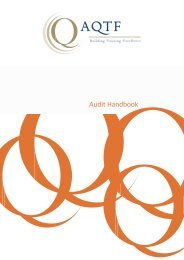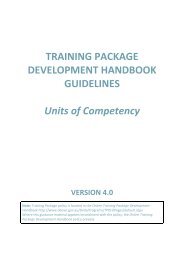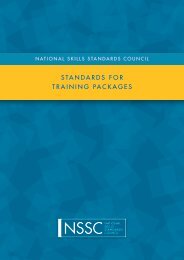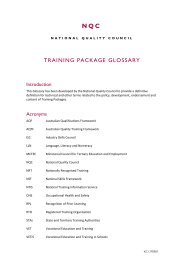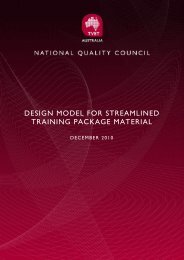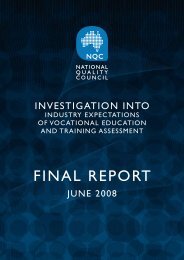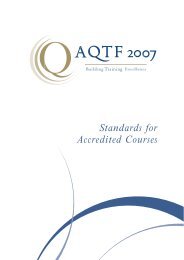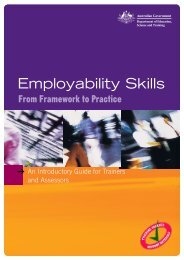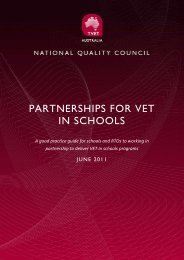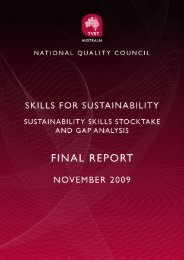VET Products for the 21st Century - National Skills Standards Council
VET Products for the 21st Century - National Skills Standards Council
VET Products for the 21st Century - National Skills Standards Council
Create successful ePaper yourself
Turn your PDF publications into a flip-book with our unique Google optimized e-Paper software.
5 . 3 A s s e s s m e n t r e q u i r e m e n t sThe combination of defining competency as ‘<strong>the</strong>ability to per<strong>for</strong>m particular tasks and duties to <strong>the</strong>standard of per<strong>for</strong>mance expected in <strong>the</strong>workplace’ coupled with <strong>the</strong> requirement <strong>for</strong> eachTraining Package qualification to have ‘a distinctoccupational outcome’, presents challenges <strong>for</strong> <strong>the</strong><strong>VET</strong> sector in meeting <strong>the</strong> needs of <strong>the</strong> diversegroup of learners identified. For example:• There can be limited capacity to acquire and have competence assessed <strong>for</strong> those studentspreparing <strong>for</strong> entry to <strong>the</strong> work<strong>for</strong>ce and <strong>for</strong> fur<strong>the</strong>r learning and returning to study as <strong>the</strong>ymay not be in <strong>the</strong> work<strong>for</strong>ce;• Many international students may be disadvantaged due to employment opportunities and/or visa requirements;• Many <strong>VET</strong> learners in work are employed in occupations that may not be relevant to <strong>the</strong>irareas of training; • Students undertaking programs to articulate to Higher Education may not be seeking aspecific occupational outcome from <strong>VET</strong>; and• Different <strong>VET</strong> learners enrolled in <strong>the</strong> same qualification may have significantly different levels of experience in <strong>the</strong> workplace.Challenges such as <strong>the</strong>se, relating to <strong>the</strong> access of<strong>VET</strong> learners to a relevant workplace, are likely tointensify as <strong>the</strong> economy turns down and <strong>the</strong> labourmarket contracts.The consultations rein<strong>for</strong>ced <strong>the</strong> need <strong>for</strong> clearerdirection on <strong>the</strong> contexts in which competence canbe demonstrated. Some must be demonstrated in aworkplace context, whilst o<strong>the</strong>rs may best bedemonstrated in simulated environments orassessed in o<strong>the</strong>r ways. Some of those consultedpointed out that <strong>the</strong> nature of some workplacesmeant that, even <strong>the</strong>re, it was difficult todemonstrate <strong>the</strong> full dimensions of competence. Awide range of assessment approaches is needed toassess <strong>the</strong> understandings that underpin workplacebehaviour and per<strong>for</strong>mance in a range ofoccupational areas, while o<strong>the</strong>r areas are moreskills-oriented.As a result, <strong>the</strong> JSC recommend that <strong>the</strong> context ofassessment be clearly specified in TrainingPackage units of competency, especially where <strong>the</strong>industry can identify and demonstrate that <strong>the</strong>re arekey risks in deeming someone as competent toper<strong>for</strong>m in a workplace environment when <strong>the</strong>yhave not been assessed in one. The JSCrecommends that industry must make a case <strong>for</strong>this to <strong>the</strong> <strong>National</strong> Quality <strong>Council</strong> at <strong>the</strong> time ofTraining Package endorsement.RecommendationsThat <strong>the</strong> NQC:11. Design and develop <strong>the</strong> specifications <strong>for</strong> <strong>the</strong> proposed endorsed component relating to AssessmentRequirements.12. Ensure that <strong>the</strong> context of assessment is clearly specified in Training Package units of competency where<strong>the</strong> industry can make a case <strong>for</strong> each such targeted Unit to <strong>the</strong> <strong>National</strong> Quality <strong>Council</strong> at <strong>the</strong> time ofTraining Package endorsement.5 . 4 C r e d i t a r r a n g e m e n t sThe extent to which current arrangements <strong>for</strong>recognition of current competence are effective hasbeen <strong>the</strong> subject of considerable debate inAustralia in recent years. Credit systems havebeen, or are being, developed in a number ofcountries to <strong>for</strong>malise credit arrangements or make<strong>the</strong>m more consistent and transparent, and to allowindividuals to accumulate credit at <strong>the</strong> unit ormodule level towards full qualifications. Theytypically achieve this by assigning value to units ormodules in terms of <strong>the</strong>ir level of complexity and<strong>the</strong> amount of learning involved acrossqualifications frameworks.<strong>VET</strong> PRODUCTS FOR THE 21 ST CENTURY - 16



